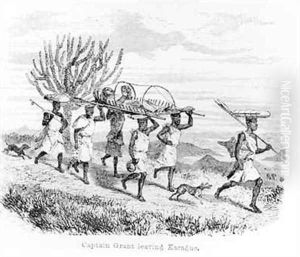Grant, James Augustus Paintings
James Augustus Grant was not an artist in the conventional sense of painters or sculptors, but his life's work as a Scottish explorer of the African continent has made a significant impact in the field of geographical and cultural documentation, which in many ways intersects with the broader narrative of art history through cartography, sketching of landscapes, and the recording of uncharted territories. Born on April 11, 1827, in Nairn, in the Scottish Highlands, Grant was educated at Marischal College, Aberdeen, and at the Addiscombe Military Seminary before joining the British Army in India. His interest in exploration was kindled by his military service, which allowed him to observe new cultures and geographies.
Grant is best known for his role as a companion to John Hanning Speke in the quest to discover the source of the Nile River, one of the great geographical mysteries of the 19th century. In 1860, under the auspices of the Royal Geographical Society, Speke and Grant embarked on an expedition that would lead them through uncharted territories in East Africa. Despite enduring tremendous hardships, including illnesses and imprisonments by local rulers, they successfully reached the northern shores of Lake Victoria and confirmed it as the source of the Nile, a discovery that was a significant contribution to the geographical knowledge of the time.
Grant's contributions to the exploration and documentation of Africa go beyond his discoveries. He meticulously recorded the journey, not just in maps and geographical notes, but also through detailed sketches and observations of the flora, fauna, and peoples they encountered. These artistic records provided invaluable insights into regions of Africa that were previously unknown to Europeans, contributing to a broader understanding of the continent's diverse cultures and landscapes.
After returning to Britain, Grant was celebrated for his achievements and contributions to the field of exploration. He published a detailed account of his travels in 'A Walk Across Africa' in 1864, which included not only maps and geographical information but also his own illustrations. These visual and written records of his travels offer a fascinating glimpse into an era of exploration that bridged the gap between geographical science and the art of documentation and observation.
James Augustus Grant passed away on February 11, 1892, but his legacy endures through his contributions to the exploration of Africa and the rich visual and written records he left behind. While not an artist in the traditional sense, his work embodies the spirit of exploration and documentation that is closely aligned with the artistic endeavors of visually capturing and understanding the world.
